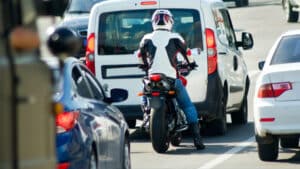
This week’s question comes from Valentino in Sausalito, who asks, “I recently read that Gov. Brown signed a bill legalizing the practice of lane-splitting for motorcyclists. Hasn’t this always been legal?”
Yes and no. Lane-splitting refers to the practice in which a motorcyclist passes other vehicles by riding between them along the lane line. Typically, this maneuver is undertaken so that motorcycles can overtake slow-moving or stopped vehicles, but the maneuver is also frequently performed when traffic is moving at higher rates of speed.
The California Vehicle Code has long required, whenever a roadway has been divided into two or more clearly marked lanes for traffic in one direction, that a vehicle be driven within a single lane and not be moved from the lane until the movement can be made with reasonable safety.
This language neither expressly authorizes nor prohibits lane-splitting. Instead, lane-splitting has been treated as acceptable by law enforcement agencies because there was no law saying otherwise.
California is unique because lane-splitting is illegal in all other states. Lane-splitting, however, is a legal practice in many European and Asian countries where it is frequently utilized in highly urbanized areas to ease traffic congestion.
Valentino, the bill you are referring to is Assembly Bill 51, sponsored by assembly members Bill Quirk and Tom Lackey. By signing the bill, Gov. Jerry Brown has made lane-splitting legal in California. AB 51 defines lane-splitting as driving a motorcycle “that has two wheels in contact with the ground, between rows of stopped or moving vehicles in the same lane, including on both divided and undivided streets, roads or highways.”
The Legislature and the governor took this step to improve highway safety and end confusion over the legality of lane-splitting. One of the main safety advantages for motorcyclists when lane-splitting on freeways is that they are not stopped behind the car ahead of them in heavy traffic, exposing them to being rear-ended by a car or truck approaching them from behind who does not see them.
This kind of rear-end collision accounts for more than 25 percent of all motorcycle-involved collisions. One study concluded that if lane-splitting was legal in all 50 states, it would likely prevent 18,000 collisions and save the lives of 170 motorcyclists each year. Furthermore, lane-splitting improves traffic flow for all motorists by effectively removing motorcycles from the traffic lanes.
Moreover lane-splitting was not specifically authorized in the Vehicle Code, no safety guidelines were published for motorcyclists on how to engage in lane-splitting safely. Similarly, the lack of guidelines meant that the state did not educate car drivers on the need to be aware of motorcyclists at all times and that lane-splitting was legal.
In fact, the California Highway Patrol published in 2013 such guidelines on its website and in the DMV’s Motorcycle Handbook, which was available throughout the state. These steps were taken by the CHP to ensure the safety and education of all motorists.
In response, a private citizen filed a complaint alleging the CHP’s lane-splitting guidelines were a set of unauthorized regulations created by a state agency instead of by the Legislature, as required by California law. As a result, the CHP removed the lane-splitting guidelines from its website and deleted them from the DMV’s Motorcycle Handbook.
By attorney Christopher B. Dolan, owner of the Dolan Law Firm. Email Chris questions and topics for future articles to help@dolanlawfirm.com










